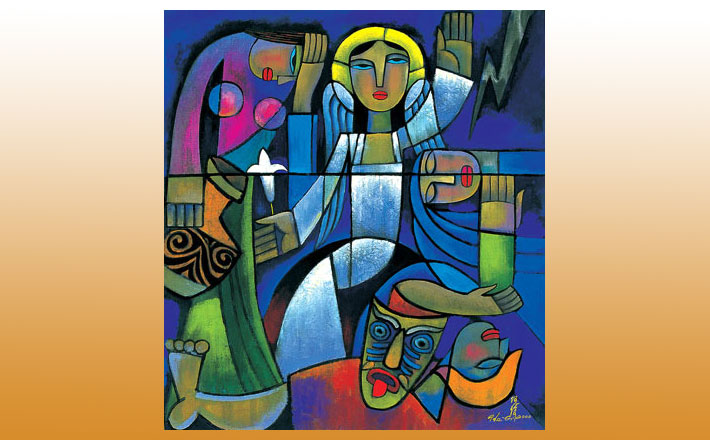Commentary on Psalm 118:1-2, 14-24
Psalm 118 is the last psalm in a group of six psalms in Book Five known as the “the Egyptian Hallel” (Psalms 113-118), psalms that are used in present-day Jewish life at the Passover meal on the eighth day of that annual spring celebration.
Psalms 113 and 114 are recited before the meal. Psalms 115-118 are recited at the conclusion of the meal while drinking the fourth cup of celebratory wine. Many scholars maintain that in ancient Jewish life Psalm 118 was used in liturgical processions, perhaps an entrance liturgy into the temple in Jerusalem. According to the Mishnah, a document that interprets the Torah, the procession around the altar that took place on seven successive days during the Feast of Tabernacles was accompanied by the recitation of Psalm 118:27.
In present-day Christian lectionary use, Psalm 118:1-2 and 14-24 is the psalm reading for Easter Sunday in all three years; Psalm 118:1-2 and 19-29 is the reading for Palm Sunday in all three years; and Psalm 118:14-29 is the psalm reading for the second Sunday of Easter in Year C. All four of the New Testament gospel writers use the words of Psalm 118:26 — “Blessed is the one who comes in the name of the Lord” — in their Palm Sunday narratives (Matthew 21:9; Mark 11:9-10; Luke 19:38; and John 12:13). In Mark 12, Jesus quotes Psalm 118:22 — “The stone the builders rejects has become a cornerstone” — as the explanation for the so-called Parable of the Vineyard. Peter quotes the same verse in Acts 4:11 in reference to Jesus; Paul alludes to it in Ephesians 2:20-21; and the words of Psalm 118:6 — “The Lord is for me; I will not fear” — echo in Romans 8:3 and Hebrews 13:6. Thus, Psalm 118 has a rich and varied history of transmission and use in both Jewish and Christian life.
The timeless appeal of Psalm 118 may have something to do with its form and content. Erhard Gerstenberger states that the psalm “abounds in liturgical forms and rhythmic, repetitious, formulaic phrases and shouts.” It is an Individual Hymn Thanksgiving, a psalm in which a single voice praises God for God’s goodness to or on behalf of that individual, usually for deliverance from some trying situation. But in Psalm 118, the words of the individual hymn singer are woven into, H.J. Kraus says “anchored in,” the liturgy of the gathered worshiping community. Thus, the psalmic voice moves back and forth between the singular and the plural, as the individual worshiper approaches God in the context of corporate worship with thanks for deliverance from trouble.
The structure of Psalm 118 may be outlined as follow:
Verses 1-4: Call to Worship
Verses 5-18: Voice of the Individual
Verses 19-28: Mingled Voices of the Individual and the Worshiping Community
Verse 29: Conclusion
The focus verses for this study, vv. 1-2 and vv. 14-24 are located in the Call to Worship and in the Mingled Voices of the Individual and the Worshipping Community.
In verse 1, worshipers are called together to “give thanks to the Lord” because of the Lord’s goodness and steadfast love (NRSV). The words of verse 1 are typical gathering words, used in many calls to worship in the Hebrew Bible (see Psalms 106:1; 107:1; 136:1; 1 Chronicles 16:34; 2 Chronicles 5:13; 7:3; 20:21). The word translated as “steadfast love” is hesed. A prominent Jewish scholar defines hesed as “a free-flowing love that knows no bounds.” Hesed is most closely connected conceptually with the covenant relationship between God and children of Israel (see Genesis 17:7 and Exodus 19:5-6, for example).
In verse 2 Israel is called upon to say (declare publicly for all to hear), “His hesed endures forever,” followed in verses 3 and 4 with a call to “the house and Aaron” and “those who fear the LORD” to do likewise. After verse 4 the word hesed does not appear again in Psalm 118 until its closing verse, v. 29. Therefore, we may be permitted to understand verses 5-28 as a description, an “example story” of hesed.
In the midst of that “example story” are our focus verses, 14-24. Verse 14 states, “God is my strength and my might; he has become my salvation,” repeating exactly the words that Moses, Miriam, and the children of Israel sang in Exodus 15:2 after they crossed the Red Sea; the singer of Psalm 118 likens the help (salvation) rendered in the present situation to the help God gave to the Israelites in the Exodus. The psalmist has escaped; the enemy has perished; a new life lies ahead.
Verses 15b and 16 echo Exodus 15 (vv.6, 12) as well, celebrating in a three-fold summary the might of the right hand of the Lord. And in verse 17, the psalmist affirms, “I shall not die, but I shall live, and recount the deeds of the LORD.” Martin Luther inscribed these very words on a wall of Colburg Castle in Bavaria during his 165 days of hiding during the Diet of Augsburg.
The words of verse 22 (“the stone the builders rejected”) are quoted and alluded to in many places in the New Testament, appropriated by its writers as a metaphor for Jesus (see Mark 12:10-12; Acts 4:11; Ephesians 2:20-21; and 1 Peter 2:4-8). In the ancient Israelite context, we may understand the “stone” as the psalm singer, who has not been cast off, but has become a cornerstone, an essential element in the construction of the life of the ancient Israelite faithful.
Verse 23 states emphatically that all of this is the Lord’s doing. The NRSV says “it is marvelous in our eyes.” The word “marvelous,” (from the Hebrew root pala’) actually means “too difficult to understand.” How could a stone that the builders reject become a cornerstone? In verse 24, the voice of the community appears clearly for the first time in the psalm and declares, “This is the day the Lord made,” and admonishes hearers, “Let us rejoice and be joyful.”
A student in the psalm class I taught in the fall of 2014 gave a presentation on Psalm 118 that incorporated a powerful additional way to understand “the stone that the builders rejected.” He told the story of Ishmael Beah, who at the age of 13 was “recruited” by a rebel government in West Africa to be a child soldier. The rebels desensitize the children to violence, make them feel like outcasts from their families, and give them little hope for any future outside the rebel groups for whom they work. But Ishmael’s story ends differently than for the majority of the children. The United Nation’s International Children’s Emergency Fund rescued him and taught him to forgive himself, to regain his humanity, and to heal. Ishmael has since committed his life to helping other children soldiers as an advocate, activist, and author. Imagine the words of Psalm 118:21-24 — “I thank you that you have answered me … the stone that builders rejected … this is the LORD’s doing” — on the lips of Ishmael Beah!


April 5, 2015